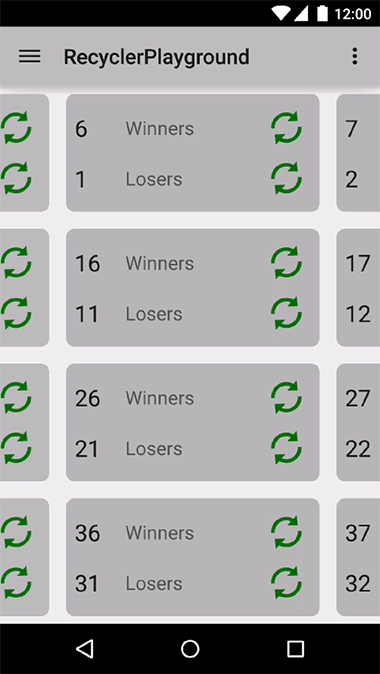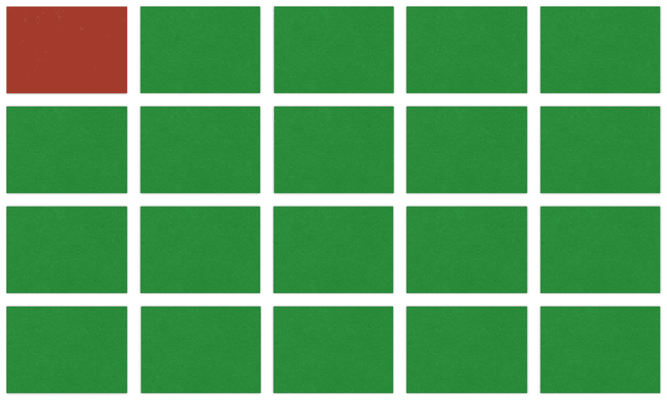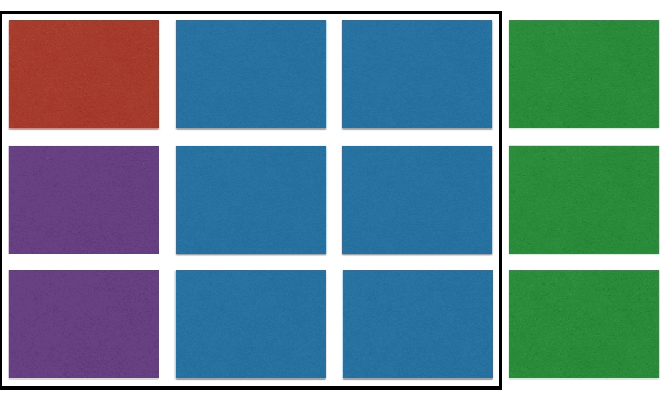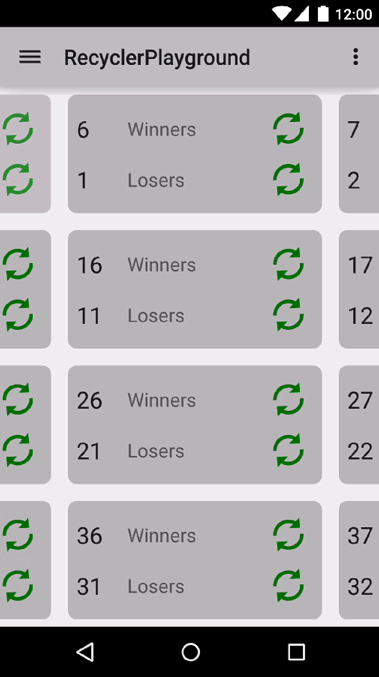Building a Recyclerview Layoutmanager Part Iii
文章目录
In the previous post, we discussed adding proper support for data set changes and targeted scrolling. In this installment of the series, we will focus on properly supporting animations in your fancy new LayoutManager.In case you’ve forgotten, the code samples are on GitHub.
The Problem With Free
We talked about notifyDataSetChanged() the last time, but you may have noticed that changing the data in this way doesn’t animate the change**. RecyclerView includes a new API for making animated changes, which requires you to notify the adapter which positions in the adapter have changed, and what the action was:
notifyItemInserted()andnotifyItemRangeInserted(): Insertion of new item(s) at the given position(s).notifyItemChanged()andnotifyItemRangeChanged(): Invalidate he item(s) at the given position(s), nothing structural has changed in the data set.notifyItemRemoved()andnotifyItemRangeRemoved(): Removal of the item(s) at the given position(s).notifyItemMoved(): An item has relocated to a new position in the data set.
By default, your LayoutManager will get “simple item animations” for free when these methods are used. These animations are simply based on whether each current view position is still present in the layout after a change. New views are faded in, removed views are faded out, and other views are moved to their new location. Here’s what our grid layout looks like with the free animations:

The problem here is that several items fade out that weren’t removed. This is because they are no longer visible inside the parent RecyclerView bounds. We would like the views to slide out of view towards where the user would expect them to go, but at this stage the framework only knows that our code didn’t lay them out again after the data set change took place. In addition, new views are fading in as if they were added. It would be better if these views slid into place from their expected locations as well.
The framework needs our help–we have to add a bit more to the LayoutManager…
Predictive Item Animations
The following animation represents what conceptually ought to happen when an item is removed:

As we discussed in the first post of the series, onLayoutChildren() is typically only called once by the parent RecyclerView during the initial layout or when the data set size (i.e. item count) changes. The predictive item animations feature allows us to provide a more meaningful description of how the views should transition based on changes in the data. We need to start by indicating to the framework that our LayoutManager is able to provide this additional data:
|
|
With this one change, onLayoutChildren() will now be called twice for each batch of data set changes–first as a “pre-layout” phase, and again for the real layout.
What Should I Do During Pre-Layout?
During the pre-layout phase of onLayoutChildren(), you should run your layout logic to set up the initial conditions for the change animation. This means that you need to layout all the views that were currently visible before the change AND any additional views that you know will be visible after the animation runs (these are termed APPEARING views). These extra appearing views should be laid out in the off-screen positions where the user would expect them to be coming from. The framework will capture these positions and use them to animate the new views into place instead of doing a simple fade-in.We can check which layout phase we are in via RecyclerView.State.isPreLayout().
In the FixedGridLayoutManager example, we use pre-layout to determine how many visible views are being removed as a result of the data set change. Removed views are still returned from the Recycler in pre-layout, so you can lay them out in their original location and not have to worry about accounting for an empty space. To indicate future removal to you, LayoutParams.isViewRemoved() will return true for the given view. Our example counts the number of removed views so we have a rough idea of how much space will get filled by appearing views.
|
|
TIP: During pre-layout, RecyclerView attempts to map the adapter positions of your views to their “old” locations (meaning before the data set change). When you ask for a view by position, expect that position to be the initial position of that item view. Beware of trying to transform them yourself between pre-layout and “real” layout.
The final change in the example comes as a modification to fillGrid() in which we will attempt to lay out “N” additional views (per row) as appearing views, where N is the number of visible views being removed. These views will always be filled in from the right on a removal, so they are computed as the positions following the last visible column:
|
|
Inside the layoutAppearingViews() helper, each additional appearing view is laid out at it’s “global” position (i.e. the row/column position it would occupy in the grid). This location is off-screen, but gives the framework the data it needs to produce a starting point for the animation to slide these views in.
Changes for the “Real” Layout
We’ve already discussed the basics of what to do during your layout in Part 1, but we’ll have to tweak the formula a bit with our animation support added. The one additional step will be to determine if we have any disappearing views. In our example, this is done by running a normal layout pass, and then determining if there are any views left in the Recycler’s scrap heap.NOTE: We can use the scrap heap in this way because our layout logic always calls detachAndScrapAttachedViews() before starting each layout pass. As discussed previously, this is the best practice to adhere to in your layouts.
Views still in scrap that aren’t considered removed are disappearing views. We need to lay these views out in their off-screen positions so the animation system can slide them out of view (instead of just fading them out).
|
|
CAUTION: Laying out views (and, thus, adding them to the container) removes them from the scrap list. Be careful to note the views you need from scrap before you start making changes, or you will end up with concurrent modification issues on the collection.
Similar to our code for the appearing views, layoutDisappearingView() places each remaining view at it’s “global” position as the final layout location. This gives the framework the information that it needs to slide these views out in the proper direction during the animation.
The following image should help to visualize the FixedGridLayoutManager example:
- The black box represents the RecyclerView visible bounds.
- Red View: Item removed from the data set.
- Green Views (Appearing views): Not initially present, but laid out off-screen during pre-layout.
- Purple Views (Disappearing views): Initially placed in their original locations during pre-layout, then laid out off-screen during the “real” layout phase.

Reacting to Off-Screen Changes
You may have noticed that our ability to determine a removal change in the last section hinged on the visible views. What if the change occurs outside the visible bounds? Depending on your layout structure, a change like this may still require you to adjust the layout for a better animation experience.
Luckily, the adapter posts these changes to your LayoutManager as well. You can override onItemsRemoved(), onItemsMoved(), onItemsAdded(), or onItemsChanged() to react to these events even if they occur in a view range that isn’t reflected in the current layout. These methods will give you the position and range of the change.
When the removed range occurs outside the visible area, onItemRemoved() is called before pre-layout. This allows us to collect data about the change that we may need in order to best support any appearing view changes that might be caused by this event.
In our example, we collect these removals in the same way as before, but mark them with a different type.
|
|
TIP: This method is sill called when the removed items are visible. In that case, however, it is called after pre-layout. This is why our example still gathers data from the visible removed views when they are present.
With all this in place, we can run the sample application again. We can see the disappearing items on the left sliding off to rejoin the end of their previous rows. The new appearing items on the right slide properly into place alongside the existing grid. Now, the only view fading out in our new animation is the view that was actually removed!

More To Come…
This was supposed to be the end of this series, I swear! However, there were some interesting issues that came up in building the animations that are specific to the FixedGridLayoutManager use case, and not necessarily all custom implementations. So in the next (and final…I promise this time) post, I’ll address what those challenges were.
The framework will attempt to animate views if your adapter uses stable IDs, which provides enough data to guess which views are removed/added/etc.
